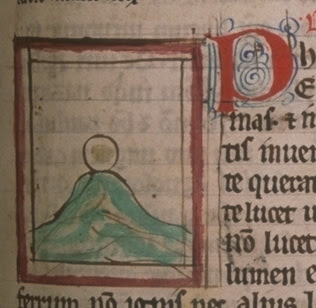I taught that course differently this time around, structuring it around the essays in the Medieval Art History Today - Critical Terms volume that was published last spring as a special issue of Studies in Iconography. In the first half of the semester, I alternated between lectures and discussions of the essays, and in the second half, I only lectured twice and we focused on discussions. Before each discussion, the students were assigned to do a "reading report" in Blackboard, answering a set of questions about the reading and posing a question or two for our class discussion. I was able to see these before class and use them to plan the class.
One of the more interesting discussions we had was about Karl Whittington's essay on "Queer." At this point in the semester, the reading report asked the students to pay special attention to the author's use of previous scholar's work and many of them asked about a word that appeared in one quote in the essay - monolithically. It's a quote from Eve Sedgewick that defines queer as "the open mesh of possibilities, gaps, overlaps, dissonances and resonances, lapses and excesses of meaning when the constituent elements of anyone's gender, of anyone's sexuality, aren't made (or can't be made) to signify monolithically" (p. 157 in the Studies in Iconography volume). After establishing the basic meaning of monolith as one-stone, I paraphrased the last part of the quote as "when the constituent elements of anyone's gender, of anyone's sexuality" don't or can't be made to act like one big stone. We were then were able to discuss what it might mean for gender and/or sexuality to be like one big stone - and why neither is really like that at all.
For me, the Adamas stone became the image of that impossible monolith: a perfectly round closed sphere, elevated as perfect up on its mountaintop; but isolated there, stranded outside of any and all relationships.
But is it really? Looking at it more closely now, I notice how its black outline not only separates from it from the surrounding parchment, but also flows down into the mountain side and then into the frame of the image and even into the form of the initial above. And so the very outline that at first seemed to set it apart as a closed form in fact creates connections into the world around it. Nothing lacks connections. And I notice that the stone isn't internally consistent: inside of that black outline is a lighter parchment patch, but then a darker center, so that the stone has internal parts that are in relationship to one another. Relationships don't have to be external. And so the monolith isn't really monolithic - perfect, closed, whole, independent - and the monolithic is again revealed to be an impossibility.
Karl's essay also set me off on a tangent of readings and re-readings - to Karma Lochrie's Heterosyncrasies and from there to the letters of Abelard and Heloise. The link being Lochrie's reference to Heloise's discussion of the issue of visitors in the monastery - specifically female visitors in a convent of nuns. Heloise was worried about their presence as being seductive for the nuns since she writes, in my Penguin volume's translation, that "nothing is so conducive to a woman's seduction as woman's flattery, nor does a woman pass on the foulness of her corrupted mind so readily to any but another woman" (p. 161). So much for keeping your firestones separate! And yet in reading her letters, what struck me more was her confession of her own continuing desire for Abelard, probably because it seems much more personal, where her discussion of the nuns' visitors is shaped by the official discourse of misogyny. Her description of lost love also resonated with my own feelings this fall. She writes: "In my case, the pleasures of lovers which we have shared have been too sweet - they can never displease me, and can scarcely be banished from my thoughts. Wherever I turn they are always there before my eyes, bringing with them awakened longings and fantasies that will not even let me sleep...Everything we did and also the times and places are stamped on my heart along with your image so that I live through it all again with you. Even in sleep I know no respite. Sometimes my thoughts are betrayed in a movement of my body, or they break out in an unguarded word" (p. 133). Abelard's response to her broader question about the nuns' situation - no visitors and keeping silence - advises becoming monolithic - closing and isolating the community and the body - and yet her expression of the unwanted effects of desire of her body and her mind shows that to be impossible. Again, relationships don't have to be external.
Finally, this fall, even as firestones and monoliths have been on my mind, I've been making paintings of various stones that I picked up last summer on the Oregon coast. These are done in watercolor pencil on hot press paper. They are small, 2 inches by 1.5 inch; in part because it's easier to get a saturation of color in watercolor when working small, in part because I like small things, and in part because I want them to resemble the paint chips you might get at a hardware store - while being obviously handmade. The shapes, then, are not meant to replicate the shapes of the stones. The only qualities of the stones that I am paying attention to are color and texture. Here are three, photographed with the original stones. And while each is a single stone, none has the quality of a monolith, for each has overflowed its boundaries to some degree and each has internal variations and differentiations.




Beautiful post ... and wonderfully creative art. You really know how to listen to stones!
ReplyDeleteComing from you, Jeffrey, that's a serious compliment.
ReplyDelete